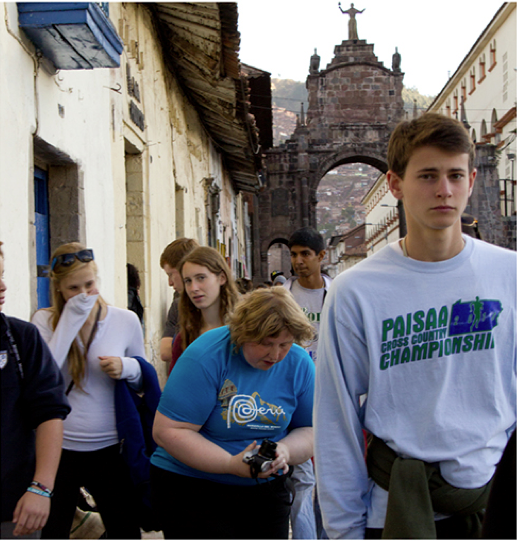Guest Correspondent: Emily Dianne Cram
A fair skinned white woman pivots casually in the middle of a crowded urban sidewalk, her hands tucked away inside mint green shorts. Her thumbs steadily line the top of her hips, as she casts a flat look somewhere beyond the frame of the photograph. And even though she occupies the center of the image, adorned with vibrant colors and tight fitting summer chic, her body is not necessarily the curious object of the photograph. We might keep our focus on her as we imagine what circumstances created this moment of pause—perhaps she’s a tourist taking in the sites or maybe even a fashion model. After all, her pose in this moving public space breaks with the uniform walking of the crowd behind her, dressed in black business suits and other muted tones. Yet, even though the camera invites our attention to her body, it also calls attention to the grimaced look on the face of the spectator to her right who fixates her disapproving gaze on the woman’s body. It is difficult to identify the valence of her expression. Perhaps she disapproves of such a bold aesthetic on a female body that violates norms of slender and seamlessness. Or perhaps it is a look of disgust generated by a body’s excess and its inability to be properly contained by standardized clothing.
I encountered Hailey Morris-Cafiero ‘s photograph series “Wait Watchers” after a Facebook friend shared a blog link describing her project. “Wait Watchers” relies on the photographic potential of everyday life, and documents the encounters Morris-Cafiero’s body has with strangers in public spaces. After staging a camera in crowded public scenes, Morris-Cafiero waits to be looked at as the camera documents policing glances like the one above. As I scrolled through a number of photographs, I felt a stunning sense of familiarity in each scene, as a fat woman who also often catches the looks of others in public policing my muffin top.* The photos created a strong sense of identification with the experience of being looked at in such a way, and encouraged me to share the photos with my own Facebook network. Others “liked” and shared the blog as well, drawing comments from others ranging from the need to reflect on their own practices of public looking to the ethics of such an artistic project. But more, I was caught by repetition in the claim that the stranger in each image could be looking at something else, not necessarily directly at Morris-Cafiero’s body, and thus, not engaging in an act of ridicule with certainty.
The desire for certainty of the alignment between relations of looking and being looked-at evokes what Ariella Azoulay terms a professional way of engaging with photography. The professional gaze seeks little more than to identify and categorize. However, even though Morris-Cafiero’s photo series asks for public witness to her experiences, to say the photos simply seek to shame the particular individuals caught looking on camera misses the project’s power.
In this photo, one not featured in the initial blog, we gain a different sense of the stakes of the project. Here, the camera’s presence is manifest: two young teens moving through what seems to be a tourist space stare directly at the camera witnessing a crowded sidewalk. Here, their movements are as much on display as Morris-Cafiero, who seems to be adjusting the lens of her camera or bending her body towards the ground below her. Meanwhile, another young tourist looks in the direction of Morris-Cafiero, covering a smirk and an emerging laugh with her sleeve covered hand. The gesture demonstrates the limits of performing bourgeois propriety, as she attempts to contain and privatize what is likely to be an act of publicly shaming Morris-Cafiero.
Both photos featured here draw attention to habits of looking that make bodies appear strange in public. More broadly, the project lends focus to encounters with bodies constituted as out of place because they violate aesthetic norms or because they violate dominant logics of how bodies should properly occupy public spaces. Morris-Cafiero’s body interrupts the efficient flow and movement of others on sidewalks or in alleyways as much as she violates fashionable gender regimes.
And so even as the question of certainty animated by the professional gaze might motivate us to contemplate the motive of onlookers (is she really being mocked?), those questions matter less than how the photographic spectator is asked to intervene in the problem that the photo series suggests: how does one engage with the social relation of looking and lookism? Morris-Cafiero’s project illustrates how relations of looking can operate as both sites of surveillance of strange bodies for their laughable deviance and as a mode of looking back, making these disciplining gestures the object on display. By making relations of looking visible to photographic spectators, Morris-Cafiero’s is both spectator and actor. How one intervene in these two fields depends on the spectator. Because the photographic spectator is also witness to these acts, the question is, what is our obligation? The professional gaze is a possibility, yet it diminishes the potential of the civic as a mode of transforming the social conditions that make these looking relations possible. And so do we pity Morris-Cafiero? Empathize with the sheer banality of these moments? Shame the watchers? Seek compassion?
We will have to wait and watch.
*NOTE: “Fat” and “fatness” are often evoked as derogatory ways of describing bodies in gendered, raced, and classed terms. My use of these categories operates in tandem with writers, thinkers, and activists working to understand fat embodiments beyond the registers of medicalization and aesthetic norms.
Emily Dianne Cram is a PhD candidate in the Department of Communication and Culture at Indiana University. She can be contacted at emcram@indiana.edu.


Where I live in Congress, AZ, there’s a lot of people who raise the question, “What do they see when they look in the mirror?”
Shame the judgy little eyes and minds.